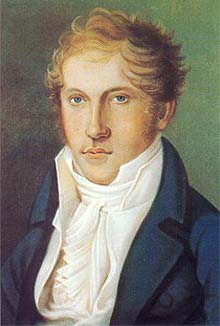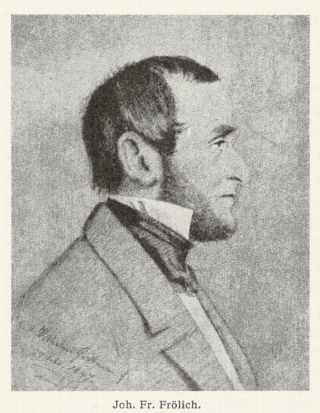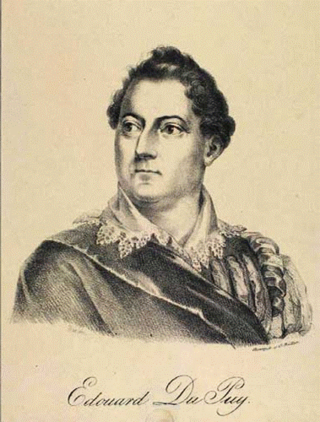Related Research Articles

Carl August Nielsen was a Danish composer, conductor and violinist, widely recognized as his country's most prominent composer.

Louis Spohr, baptized Ludewig Spohr, later often in the modern German form of the name Ludwig was a German composer, violinist and conductor.

Carl Ditters von Dittersdorf was an Austrian composer, violinist, and silvologist. He was a friend of both Haydn and Mozart. His best-known works include the German Singspiele Doktor und Apotheker and a number of programmatic symphonies based on Ovid's Metamorphoses.

Niels Wilhelm Gade was a Danish composer, conductor, violinist, organist and teacher. Together with Johan Peter Emilius Hartmann, he was the leading Danish musician of his day, in the period known as the Danish Golden Age.

Wolfgang Eduard Schneiderhan was an Austrian classical violinist.

Ferdinand Ries was a German composer. Ries was a friend, pupil and secretary of Ludwig van Beethoven. He composed eight symphonies, a violin concerto, nine piano concertos, three operas, and numerous other works, including 26 string quartets. In 1838 he published a collection of reminiscences of his teacher Beethoven, co-written with Beethoven's friend, Franz Wegeler. Ries' symphonies, some chamber works—most of them with piano—his violin concerto and his piano concertos have been recorded, exhibiting a style which, given his connection to Beethoven, lies between the Classical and early Romantic styles.

Frederik Reesen Magle is a Danish composer, concert organist, and pianist. He writes contemporary classical music as well as fusion of classical music and other genres. His compositions include orchestral works, cantatas, chamber music, and solo works, including several compositions commissioned by the Danish royal family. Magle has gained a reputation as an organ virtuoso, and as a composer and performing artist who does not refrain from venturing into more experimental projects – often with improvisation – bordering jazz, electronica, and other non-classical genres.
The Bergen Philharmonic Orchestra is a Norwegian orchestra based in Bergen. Its principal concert venue is the Grieg Hall.

Otto Valdemar Malling was a Danish composer, from 1900 the cathedral organist in Copenhagen and from 1889 professor, then from 1899 Director of the Royal Danish Academy of Music, Copenhagen.

Johannes Frederik Fröhlich, a Danish violinist, conductor and composer, was a precursor of Niels Gade and J.P.E. Hartmann, and a central figure in Danish musical circles during the Romantic era.
A solo concerto is a musical form which features a single solo instrument with the melody line, accompanied by an orchestra. Traditionally, there are three movements in a solo concerto, consisting of a fast section, a slow and lyrical section, and then another fast section. However, there are many examples of concertos that do not conform to this plan.

Emil Hartmann was a Danish composer of the romantic period, fourth generation of composers in the Danish Hartmann musical family.

Peter Erasmus Lange-Müller was a Danish composer and pianist. His compositional style was influenced by Danish folk music and by the work of Robert Schumann; Johannes Brahms; and his Danish countrymen, including J.P.E. Hartmann.
Paul August von Klenau was a Danish-born composer who worked primarily in Germany and Austria.

Georg Gerson was a Danish composer and banker. Most of his works are orchestral.

Jean Baptiste Édouard Louis Camille Du Puy was a Swiss-born singer, composer, director, and violinist. He lived and worked in Copenhagen and Stockholm from 1793 until his death in 1822.
Johann Ernst Hartmann was a Danish classical composer and violinist. He is remembered in particular for his two operas on texts by Johannes Ewald in which he helped creating a national musical style. The first of these, Balders død, builds on the old Nordic mythology and uses dark colours when depicting the old Gods and Valkyries. The second, Fiskerne, describes contemporary fishermen’s lives, and uses melodies inspired by the Scandinavian folk style.
Carl Nielsen's Concerto for Violin and orchestra, op. 33 [D.F.61] was written for Peder Møller (1877-1940) in 1911. It has two movements, both opening with a slower prelude.
John Abraham Fisher was an English violinist and composer.

The Tonkünstler-Societät was a benevolent society for musicians in Vienna, which lasted from the mid-18th century to the mid-20th. Its purpose was "to support retired musicians and their families". Beginning in 1772, the Society mounted a series of benefit concerts, often with large forces of performers, at which were performed works by leading Classical-period composers, including Joseph Haydn, Wolfgang Amadeus Mozart, and Ludwig van Beethoven.
References
![]() This article incorporates text from this source, which is in the public domain : Salmonsens Konversationsleksikon , Vol. VI – 2nd edition, pp. 188–189 , editor: Christian Blangstrup , Copenhagen: J. H. Schultz Forlagsboghandel, 1915-1930
This article incorporates text from this source, which is in the public domain : Salmonsens Konversationsleksikon , Vol. VI – 2nd edition, pp. 188–189 , editor: Christian Blangstrup , Copenhagen: J. H. Schultz Forlagsboghandel, 1915-1930